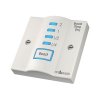My house has the usual hot water tank found in Irish houses, with two heating elements, “Sink” and “Bath”. It’s got the bog standard immersion switch, two toggles, one On/Off, the other Sink/Bath:

I intend to add a boost switch to this set up, or ideally, replace the old switch with a new boost configuration. The boost switch I have in mind is one of these:

One button that’ll give you four times (15/30/60/120 minutes), and “Off”.
However, I’m wondering if there is a dual version of this?
As the hot water tank has two elements I’d rather one dual boost switch rather than two single boost switches. The only alternative I can think of is to use the original switch with one single boost switch. Which would be a bit clunky.
As I write this it’s coming clearer in my head that maybe the best solution in the absence of a dual boost switch is to use two single boost switches side-by-side, labelled, “Sink” and “Bath” as appropriate.
I’m wondering if any other members have considered this switch? Or any other thoughts?
I intend to add a boost switch to this set up, or ideally, replace the old switch with a new boost configuration. The boost switch I have in mind is one of these:
One button that’ll give you four times (15/30/60/120 minutes), and “Off”.
However, I’m wondering if there is a dual version of this?
As the hot water tank has two elements I’d rather one dual boost switch rather than two single boost switches. The only alternative I can think of is to use the original switch with one single boost switch. Which would be a bit clunky.
As I write this it’s coming clearer in my head that maybe the best solution in the absence of a dual boost switch is to use two single boost switches side-by-side, labelled, “Sink” and “Bath” as appropriate.
I’m wondering if any other members have considered this switch? Or any other thoughts?
